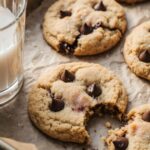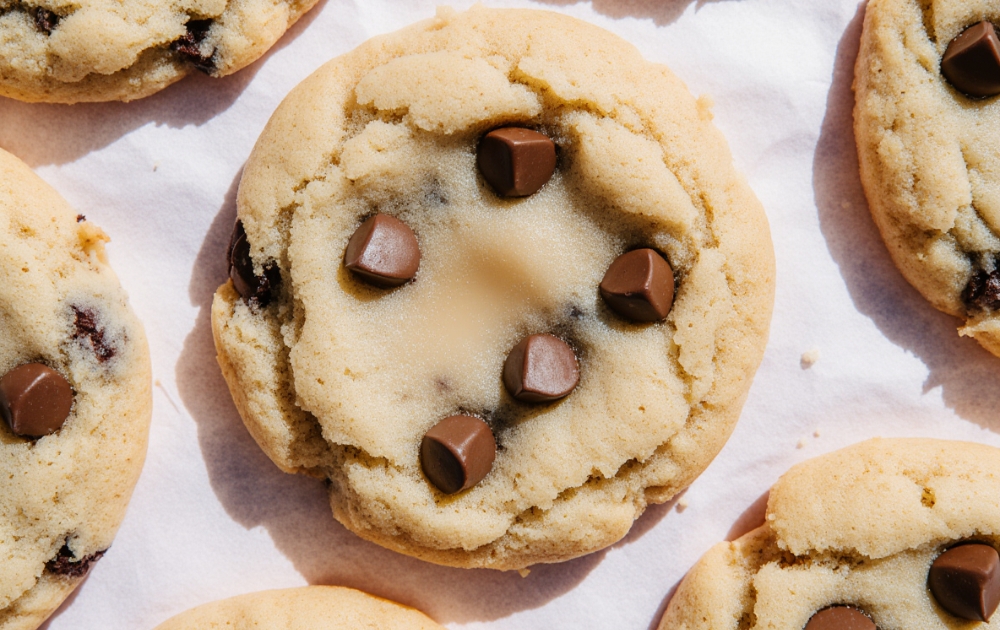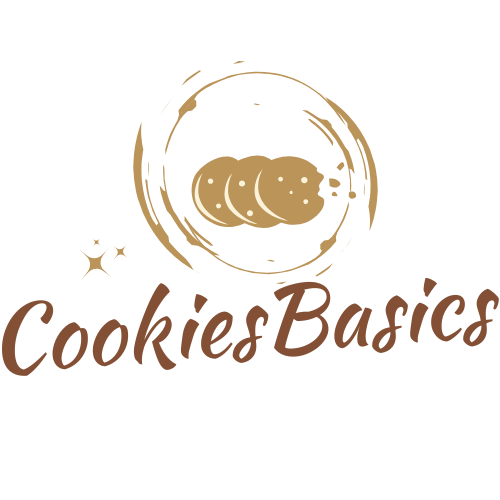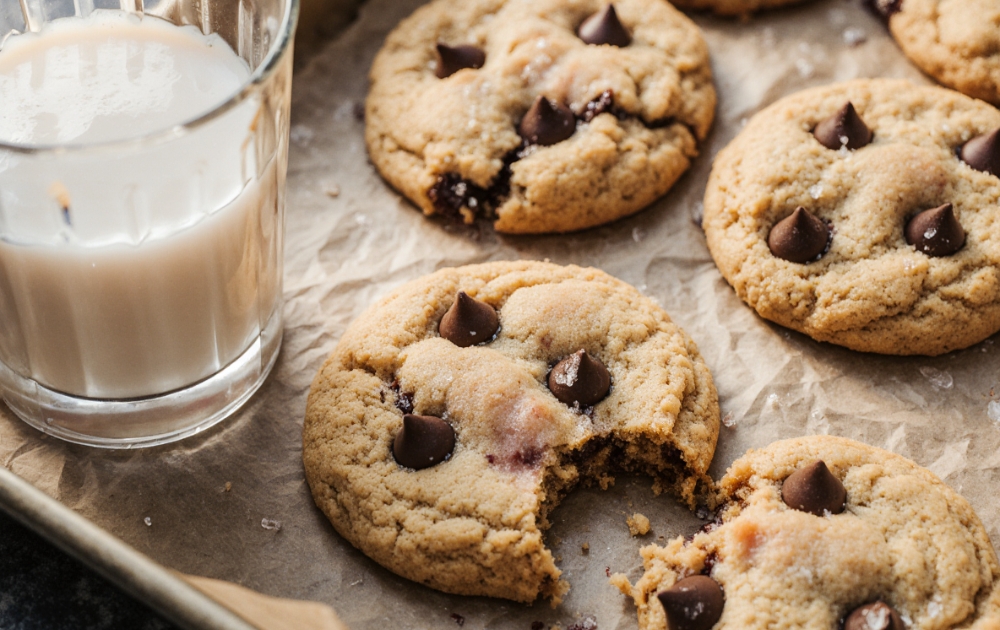Gluten and dairy free cookies aren’t just a trend—they’re a reflection of changing needs, heartfelt memories, and inclusive kitchen creativity. For me, baking has always been more than a hobby—it’s a form of connection. Some of my earliest and fondest memories are of baking cookies in the kitchen with my mother. Flour-covered countertops, warm vanilla scents in the air, and laughter shared over mixing bowls—those moments didn’t just fill the house with sweetness, they filled my heart.
As I grew up and began exploring new ingredients, I realized that baking could be a bridge for people with food allergies and sensitivities to still enjoy those same magical moments. That’s how Cookies Basics was born—a space for reinventing nostalgic cookie recipes into gluten and dairy free cookies that anyone can enjoy, without compromising taste or tradition.
Whether you’re newly diagnosed with a gluten or dairy sensitivity, baking for someone who is, or simply looking for a lighter, allergen-friendly twist on your favorite sweets, this guide will walk you through the essentials. From ingredients and baking tips to storage hacks and FAQs, everything here is designed to help you create cookies that taste just as good—if not better—than the originals.
Looking for inspiration? Try our reader-favorite gluten-free crumbl cookies recipe that combines soft texture with bold flavor—it’s a hit for all occasions.
Let’s get started with the “why” behind these treats.
Table of Contents
Table of Contents
Why Choose Gluten and Dairy Free Cookies?
What Does “Gluten and Dairy Free cookies” Really Mean?
Gluten is a protein found in wheat, barley, and rye—ingredients common in traditional cookie recipes. Dairy includes ingredients like butter, milk, and cream, which are often used for flavor and texture. Removing both can seem like a challenge at first, but it opens the door to a new world of inclusive, nutrient-rich, and allergy-friendly baking.
Gluten and dairy free cookies use substitutes that are just as delicious but easier on the digestive system for those with sensitivities, intolerances, or allergies. These cookies are safe for people with celiac disease, lactose intolerance, or anyone following a plant-based diet.
The Rise in Food Sensitivities and Lifestyle Shifts
According to the CDC, food allergies among children increased by 50% from 1997 to 2011. Adults are increasingly affected too. This shift has sparked demand for recipes that don’t rely on common allergens but still deliver satisfaction.
Plus, people are choosing gluten- or dairy-free options not only for health reasons but also for personal and ethical reasons, like reducing inflammation, improving gut health, or embracing veganism. With this shift, traditional cookie recipes are evolving—and the results are mouthwatering.
Discover great ideas like our vegan peanut butter cookies that use only 4 ingredients and zero dairy.
Benefits of Gluten and Dairy Free Cookies Recipes
So, why bake without gluten and dairy? Here are a few standout reasons:
| Benefit | Description |
|---|---|
| Digestive Comfort | Fewer bloating, cramping, or skin issues from intolerances |
| Inclusive for Everyone | Safe to share at parties or events with dietary-restricted guests |
| Ingredient Awareness | Encourages healthier, cleaner eating habits |
| Allergen-Free Indulgence | Kids and adults with allergies can still enjoy baked treats |
| Lower Saturated Fat | Dairy-free baking often leads to heart-healthier fat sources |
Don’t miss our guide to healthy oatmeal cookies that offer fiber, natural sweetness, and allergen-friendly goodness in every bite.
As you’ll soon see, baking without gluten and dairy doesn’t mean baking without love, flavor, or nostalgia. In fact, it can be the beginning of a whole new baking journey.
Essential Ingredients for Gluten and Dairy Free Baking
Top Gluten Free Flours for Cookies
When baking gluten and dairy free cookies, choosing the right flour is your first step to success. Without traditional all-purpose flour, your cookie dough needs support from alternatives that offer structure, chew, and flavor.
Here are the top choices:
| Gluten-Free Flour | Texture & Flavor | Best For |
|---|---|---|
| Almond Flour | Nutty, moist | Chewy cookies, protein boost |
| Oat Flour | Soft, earthy | Breakfast-style cookies |
| Brown Rice Flour | Mild, grainy | Crisp cookies |
| Coconut Flour | Dry, sweet | Use in small amounts with others |
| Sorghum Flour | Neutral, firm | Classic-style cookies |
Each type of flour has its own unique qualities. Almond flour, for example, adds richness and a tender texture, making it ideal for chocolate chip cookies. Oat flour, when certified gluten-free, creates fluffy textures with a wholesome twist. You can even combine flours for a more balanced result, such as almond-oat or oat-sorghum blends.
Check out our delicious protein oatmeal cookies where oat flour does the heavy lifting while keeping things naturally gluten-free.
Best Dairy-Free Substitutes
Dairy ingredients like butter and milk add richness, but they’re easy to swap in gluten and dairy free cookies without missing a beat.
Here are common and reliable substitutes:
- Coconut Oil or Vegan Butter: Both mimic the fat and moisture of butter. Choose solid-at-room-temperature versions for creaming.
- Unsweetened Applesauce: Adds moisture and a touch of sweetness—best for chewy cookies.
- Almond or Oat Milk: Light and creamy, these plant-based milks blend smoothly into cookie dough.
- Nut Butters: Peanut, almond, and cashew butters add richness and protein—ideal for flourless cookies.
For a creamy yet dairy-free flavor, vegan butter works best in classic-style recipes. If you’re making something more rustic, coconut oil is excellent for crisp edges. Looking for bold nutty flavor? Nut butters give body and richness naturally.
Don’t miss our signature stuffed cookies, which use coconut oil for that irresistible soft center.
Using these ingredients doesn’t just make your cookies allergen-safe—they enhance texture and flavor in ways traditional recipes sometimes can’t. When you’re crafting gluten and dairy free cookies, you’re not just replacing ingredients; you’re reimagining the recipe entirely.
And that’s the beauty of it.
Techniques for Making Soft and Chewy Cookies
Understanding Texture Challenges in Allergen-Free Baking
When baking gluten and dairy free cookies, one of the biggest hurdles is texture. Without gluten, which helps create that soft chew and structure in traditional cookies, your dough can fall apart or turn out dry. And without dairy, you lose the creamy richness that usually brings everything together.
But don’t worry. Soft, chewy, bakery-style cookies are still within reach. You just need to understand a few basic tricks that make a big difference.
First, moisture matters. Gluten-free flours often absorb more liquid than regular ones, which means your dough can become crumbly fast. To fix that, increase your wet ingredients just slightly—think a splash more plant-based milk or an extra spoonful of applesauce.
Second, resting the dough helps. Let your cookie dough sit for 20–30 minutes before baking. This allows the gluten-free flours to hydrate properly, leading to a better texture after baking.
Lastly, don’t skip the binding agents. Since there’s no gluten to hold things together, you can use natural binders like flaxseed meal mixed with water (known as a flax egg), chia seeds, or even mashed banana for a soft, chewy finish.
Tricks for Moisture Retention and Binding Without Gluten
The secret to great gluten and dairy free cookies isn’t complicated—it’s all about balance. Here are some tried-and-true tips to keep your cookies moist, chewy, and flavorful:
- Don’t Overbake: Take cookies out just as the edges turn golden. They’ll continue to cook on the tray.
- Add a Splash of Vinegar: A little apple cider vinegar enhances the rise and keeps cookies tender.
- Chill the Dough: Refrigerating dough for an hour helps prevent spreading and improves the structure.
Here’s a quick reference table:
| Problem | Quick Fix |
|---|---|
| Dry dough | Add 1-2 tbsp dairy-free milk |
| Flat cookies | Chill the dough for 30 mins |
| Crumbly texture | Add a flax egg or extra nut butter |
| Too dense | Use a mix of flours and baking soda |
When baking without gluten and dairy, think of it as an experiment—one where the reward is delicious cookies everyone can enjoy.
Remember: gluten and dairy free cookies aren’t lesser versions. They’re just different. And with the right techniques, they’re downright irresistible.
Easy Gluten and Dairy Free Cookie Recipes
Classic Chocolate Chip Cookies Without Gluten or Dairy
You don’t need traditional ingredients to enjoy a warm, gooey chocolate chip cookie. One of the most popular and comforting recipes in the world can be completely reimagined into gluten and dairy free cookies that are just as crave-worthy.
Here’s a simple, foolproof recipe:
Ingredients
- 1 ½ cups almond flour
- ½ cup coconut sugar
- ¼ cup melted coconut oil
- 2 tbsp almond milk
- 1 tsp vanilla extract
- ½ tsp baking soda
- ½ cup dairy-free chocolate chips
- Pinch of sea salt
Instructions
- Preheat oven to 350°F.
- Mix all ingredients in a bowl until dough forms.
- Scoop dough onto a parchment-lined baking sheet.
- Bake for 10–12 minutes, or until the edges turn golden.
- Cool for 5 minutes before serving.
These cookies are soft, slightly chewy, and packed with chocolate in every bite. They’re proof that gluten and dairy free cookies don’t sacrifice flavor—they elevate it.
3-Ingredient Cookie Recipe for Quick Snacking
Sometimes, less is more. When you’re short on time (or pantry staples), this three-ingredient cookie delivers big on flavor with minimal effort—and yes, it’s completely free from gluten and dairy.
You’ll need:
- 1 ripe banana
- 1 cup gluten-free oats
- ¼ cup nut butter (peanut, almond, or sunflower)
Directions:
- Preheat oven to 350°F.
- Mash banana in a bowl. Mix in oats and nut butter.
- Shape into small balls and bake for 10–12 minutes.
That’s it! No dairy, no gluten, no problem. These cookies are naturally sweet, chewy, and perfect for a quick energy boost or a guilt-free dessert. They’re also kid-friendly and customizable—add raisins, chocolate chips, or shredded coconut for extra fun.
You don’t need special equipment to bake delicious gluten and dairy free cookies, but having a few simple tools can really help.
Print
Gluten and Dairy Free Cookies: The Best 7 Tips You Need Now
- Total Time: 22 minutes
- Yield: About 12 cookies 1x
Description
Soft, chewy, and perfectly sweet, these gluten and dairy-free cookies are simple to make and easy to customize with your favorite mix-ins.
Ingredients
-
1 ½ cups almond flour
-
½ cup gluten-free rolled oats
-
¼ cup coconut sugar
-
½ tsp baking soda
-
¼ tsp salt
-
1 egg (or flax egg for vegan option)
-
3 tbsp coconut oil, melted
-
1 tsp vanilla extract
-
½ cup dairy-free chocolate chips (optional)
-
2 tbsp sunflower or chia seeds (optional, for texture)
Instructions
-
Preheat oven to 175°C (350°F) and line a baking sheet with parchment paper.
-
In a large bowl, whisk together almond flour, oats, coconut sugar, baking soda, and salt.
-
In a separate bowl, mix egg, melted coconut oil, and vanilla extract.
-
Combine wet and dry ingredients, then fold in chocolate chips and seeds if using.
-
Form dough into small balls and place on the baking sheet.
-
Bake for 10–12 minutes, or until edges are golden.
-
Let cool for a few minutes on the baking sheet before transferring to a wire rack.
Notes
-
Make sure not to overpack flour as gluten-free flours absorb more liquid.
-
Feel free to swap chocolate chips with nuts, dried fruit, or seasonal mix-ins.
-
Store in an airtight container for up to 4 days.
- Prep Time: 10 minutes
- Cook Time: 12 minutes
- Category: Dessert
- Method: Baking
- Cuisine: Gluten-Free, Dairy-Free
Nutrition
- Calories: 140
- Sugar: 6g
- Fat: 9g
- Carbohydrates: 12g
- Fiber: 2g
- Protein: 3g
Tools and Storage Tips for Allergen-Free Cookies
Must-Have Tools for Gluten and Dairy Free Cookies
You don’t need a fancy setup to bake great gluten and dairy free cookies, but a few basic tools can make a big difference:
- Cookie scoop – for even portions
- Silicone baking mat – helps cookies bake evenly
- Hand mixer – makes mixing thick doughs easier
- Cooling rack – avoids soggy bottoms after baking
Simple tools = better results, especially when you’re working with gluten-free flours or dairy-free alternatives. For soft, chewy results, accuracy is key
How to Store Gluten and Dairy Free Cookies
After baking, proper storage keeps your cookies soft and fresh:
| Where to Store | How Long | Pro Tip |
|---|---|---|
| Room temp (airtight) | 3–4 days | Store in a cool spot |
| Fridge | 1 week | Bring to room temp before eating |
| Freezer | 2–3 months | Freeze in layers with parchment |
Let cookies cool fully before storing, or they’ll turn soggy. For long-term cravings? Freeze cookie dough balls and bake when needed.
With just a little planning, your gluten and dairy free cookies will stay delicious day after day.

Comparing Store-Bought vs Homemade
Are Store-Bought Gluten and Dairy Free Cookies Worth It?
Walk into any grocery store today, and you’ll spot at least a few brands offering gluten and dairy free cookies. They’re quick, convenient, and often labeled as healthy—but are they really better?
Most packaged options tend to be:
- More expensive per serving
- Loaded with stabilizers and added sugars
- Lower in freshness and texture
While they’re handy in a pinch, store-bought versions often fall short in flavor and nutrition compared to homemade ones.
If you’re looking for real, whole-food ingredients and total control over taste, homemade is the way to go.
Homemade Cookies: The Better Choice?
When you bake gluten and dairy free cookies at home, you choose the ingredients. You can skip preservatives, control the sweetness, and get the exact texture you want—chewy, crispy, or soft.
Plus, baking at home means:
- You can adjust for other allergies (like nuts or eggs)
- You’ll get fresher, better-tasting cookies
- You can freeze extras for later
In the end, homemade wins for flavor, customization, and cost. And nothing beats the smell of fresh cookies filling your kitchen.
Exploring More Flavor Combos
Fun Mix-Ins for Gluten and Dairy Free Cookies
Just because you’re baking gluten and dairy free cookies doesn’t mean you’re limited to basic flavors. You can mix in bold, fun, and seasonal ingredients to keep things exciting.
Try these crowd-pleasing add-ins:
- Chopped nuts: almonds, pecans, or walnuts for crunch
- Dried fruit: cranberries, cherries, or raisins add sweetness
- Seeds: Add sunflower or chia seeds for extra texture and a boost of protein.
- Dairy-free chocolate: dark, mini chips, or chunks
- Coconut flakes: for a tropical twist
These extras not only add flavor—they boost nutrition too. And best of all, they keep your gluten and dairy free cookies anything but boring.
Holiday Cookie Ideas That Stay Allergy-Friendly
Holidays are cookie season. With a little planning, you can serve gluten and dairy free cookies everyone will love—no one will miss the traditional stuff.
Try these festive combos:
- Pumpkin spice + oats for fall
- Peppermint + chocolate chips for winter
- Lemon + coconut for spring
- Cinnamon + raisins for cozy anytime cookies
Seasonal flavors are a simple way to keep your recipes fresh and fun. And since they’re allergen-friendly, they’re perfect for potlucks, school events, and parties.
With the right mix-ins, your cookies can fit the season, your mood, or whatever you’re craving—all while staying gluten and dairy free.
Nutritional Insights of Gluten and Dairy Free Cookies
Are Gluten and Dairy Free Cookies Healthier?
People often assume gluten and dairy free cookies are automatically healthy—but that’s not always the case. The truth is, it depends on the ingredients.
When made at home with wholesome swaps, these cookies can be:
- Lower in saturated fat (thanks to coconut oil or nut butters)
- Higher in fiber (from oats or almond flour)
- Free from refined sugars if you use maple syrup or coconut sugar
So yes—they can be healthier, especially when compared to processed, sugar-heavy traditional cookies.
Understanding Labels: “Free From” vs “Certified”
Not all products labeled “gluten-free” or “dairy-free” are safe for everyone. If you’re baking for someone with celiac disease or severe allergies, it’s important to check that ingredients are certified gluten-free and processed in allergen-free facilities.
Here’s what to look for:
- Certified Gluten-Free stamp
- Non-Dairy or Vegan labeling
- No hidden dairy (like casein, whey, or milk solids)
Making gluten and dairy free cookies at home gives you full control—you know exactly what’s in every bite. And when you focus on clean, simple ingredients, your cookies can satisfy cravings and support health goals at the same time.
Common Mistakes to Avoid When Baking Gluten and Dairy Free
Why Your Cookies Might Crumble
One of the biggest challenges when baking gluten and dairy free cookies is getting the texture just right. Without gluten to bind ingredients and dairy to add moisture, things can go wrong fast.
Here’s what to watch for:
- Too much flour: Gluten-free flours soak up more liquid, so measure carefully and avoid overpacking.
- Skipping a binder: Flax egg, chia seeds, or nut butter help hold cookies together.
- Overbaking: These cookies cook fast—remove when edges are just golden.
A little attention makes a big difference. Always test a small batch first before baking the whole tray.
Ingredient Swaps That Backfire
Not all swaps are equal. Some ingredients sound like good replacements—but they can hurt texture or flavor.
Avoid these common mistakes:
- Using only coconut flour: It’s too dry—always blend it with others.
- Skipping salt: Salt balances sweetness—don’t forget it.
- Choosing the wrong oil: Olive oil can be too strong—use neutral oils like avocado or coconut instead.
Baking gluten and dairy free cookies isn’t about guessing—it’s about balance. The right combos give you cookies that are soft, rich, and full of flavor.
And when in doubt, keep it simple. Some of the best cookies come from just a few good ingredients and a little patience.
For more recipes follow me in facebook
Conclusion: Baking Gluten and Dairy Free Cookies with Confidence
Baking gluten and dairy free cookies isn’t about giving things up—it’s about baking differently and more intentionally. With just a few ingredient swaps and simple techniques, you can create cookies that are safe, satisfying, and seriously delicious.
Whether you’re baking for health, allergies, or lifestyle, remember: it’s not about perfection—it’s about joy. You don’t need gluten or dairy to make cookies that bring people together. Just good ingredients, a little love, and maybe a few chocolate chips.
FAQ: Your Most Common Questions About Gluten and Dairy-Free Cookies
Are Oreo cookies gluten and dairy-free?
No, traditional Oreos are not dairy-free or gluten-free. While there’s a gluten-free version of Oreo cookies available, they still contain dairy-based ingredients. If you’re looking for safe gluten and dairy free cookies, it’s best to stick to homemade versions or trusted allergy-friendly brands.
What snacks are gluten-free and dairy-free?
There are plenty! Popular gluten and dairy-free snacks include:
Rice cakes with nut butter
Fruit and nut bars
Hummus with veggie sticks
Homemade gluten and dairy free cookies
These options are quick, satisfying, and won’t trigger common food sensitivities.
What is the secret to good gluten-free cookies?
Moisture, binders, and patience. The secret to tasty gluten and dairy free cookies is using enough fat (like coconut oil or nut butter), a good flour mix, and allowing the dough to rest. A short chill time helps the ingredients bind better—giving you cookies that hold together and taste amazing.
What type of cookies are gluten-free?
Gluten-free cookies use flours like almond, oat, coconut, or rice instead of wheat. Many traditional styles—like chocolate chip, peanut butter, and oatmeal—can be turned into gluten and dairy free cookies with a few simple swaps.

